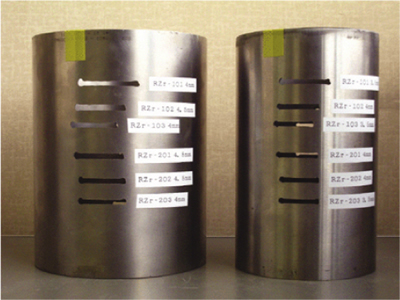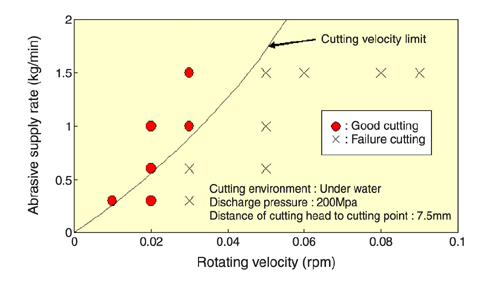Fig.9-2 Downsized AWJ cutting head

Fig.9-3 Specimen used in the experiment (The tubes were arranged coaxially and cut from inside simultaneously)

Fig.9-4 Relationship between rotating velocity of cutting head and abrasive supply rate (Specimen: thick double-tube)
Care must be taken to prevent the diffusion of radioactive materials during dismantling of nuclear facilities. In the case of cutting structural materials of the facilities, fume and/or dross may be generated due to the melting or the evaporation of the materials with heat. Especially, for the dismantling of structure containing the radioactive materials, it is desirable to choose a cutting method that produces few fumes, to suppress the diffusion of the radioactive materials. Moreover, it is required that the cutting device can be used in facilities with complicated and narrow geometries as in reactor cores.
Considering the above, the abrasive water jet (AWJ) cutting method, the head of which is relatively small, was selected as one of the favored technologies for dismantling of the core of "FUGEN". In this method, the heat generated by cutting is low, because structural materials are cut by high-pressure (200-400 MPa) water with abrasive discharged from the cutting head.
The core of "FUGEN" contains many vertical pressure tubes arranged at small intervals. It is, therefore, necessary to cut the pressure tube from its inside since this is the wider space, in the dismantling work. A downsized AWJ cutting head (Fig.9-2) which can be inserted inside the pressure tube, has been developed. Appropriate cutting conditions for dismantling the core were also determined in the experiments using a double-tube specimen simulating the pressure and calandria tubes, arranged coaxially. The experiments were carried out under the water to simulate the actual conditions of the dismantling work.
As the results of the experiments, it was confirmed that the AWJ cutting method generates few fumes, and is able to cut the two tubes at the same time (Fig.9-3). It was also clarified that the relationship between the abrasive supply rate and the nozzle rotating velocity can be expressed by considering the momentum conservation between the abrasive and the water, and the kinetic energy of the abrasive transferred to the structural materials (Fig.9-4). The optimum abrasive supply rate and cutting velocity can be also estimated using the above relation.
It is concluded that the AWJ cutting method is practical for dismantling nuclear facilities that have completed their missions. Useful data for optimizing the method were obtained in this study.
<Previous: 9 Development of Technology on Nuclear Cycle Backend | Next: 9-2 >